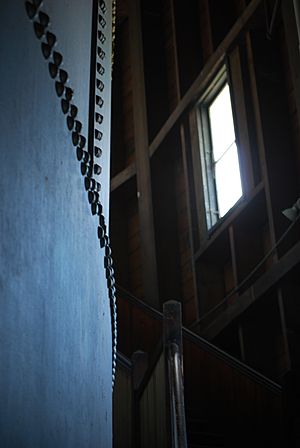Thomas Hill Standpipe facts for kids
Quick facts for kids |
|
|
Bangor Standpipe
|
|

Thomas Hill Standpipe
|
|
| Location | Jackson St Bangor, Maine |
|---|---|
| Built | 1897 |
| Architect | Ashley B. Tower; Tower & Wallace |
| NRHP reference No. | 74000185 |
| Added to NRHP | August 30, 1974 |
The Thomas Hill Standpipe is a very old and important water tower in Bangor, Maine, United States. It holds a huge amount of water, about 1,750,000 US gallons (6,624,470 liters)! This standpipe is made of strong iron plates and has a wooden building around it. It stands tall on Thomas Hill.
Built in 1897, it's known for its cool design. People in Bangor see it as a special landmark. Because of its history and unique look, it was added to the National Register of Historic Places in 1974.
Contents
History of the Standpipe
Why the Standpipe Was Built
The Thomas Hill Standpipe was built in 1897. It is the oldest water tower in the area and has been used ever since it was finished. Its main job is still the same today: to help keep the water pressure steady in downtown Bangor. It also stores water for emergencies, like fires.
Before it was built, in 1895, people found out that the city's water pumping station had problems. This meant there was a risk of not having enough water for everyone. So, building a new, reliable water storage system became very important.
Who Designed and Built It
Ashley B. Tower from Holyoke, Massachusetts, designed this amazing structure. In 1897, a company called New Jersey Steel and Iron Co. put together the huge steel tank. This tank is 50 feet (15 meters) tall and 75 feet (23 meters) wide. It sits right on top of Thomas Hill. The land for the standpipe used to belong to two brothers, James and Charles Thomas.
Building the standpipe was a big project. The total cost to build it was about $295,109.36.
Changes Over the Years
When it was first built, the outside of the standpipe was painted dark gray. Its pillars and fancy lattice work were white. During World War II, the standpipe was painted a dull olive green. This was to help hide it from enemy planes, especially because it was close to Dow Army Airfield. After the war, in 1949, it was painted white again.
The standpipe used to be open for people to visit. But it was closed during the war. This was after a safety incident in 1940. Since then, it has mostly remained closed to the public for safety reasons.
In 1957, the Bangor Water District took over the standpipe. This district is a special group that manages Bangor's water.
Recently, new safety features were added. These include a fire detection system. There's also a special "dry" sprinkler system. This system can be filled with water from a fire hydrant outside if there's a fire. These additions help protect this important landmark.
Inside the Standpipe Structure
The Thomas Hill Standpipe is actually like two buildings in one. The real water tank is made of strong steel plates. These plates are riveted together, one on top of the other. The building that covers this tank is 85 feet (26 meters) wide and 110 feet (34 meters) tall.
Building Materials
The main supports for the wooden building are 24 large posts. These posts are made of strong hard pine wood. Each post is 12 by 12 inches (30 by 30 cm) thick and 48 feet (15 meters) long. They go all the way up past the observation deck.
The entire structure sits on a stone foundation. This foundation is 9 feet (2.7 meters) high. It is 3.5 feet (1.1 meters) thick at the bottom. On top of the foundation is a thick sill. This sill is made of bent pine planks and is 14 inches (36 cm) thick.
The Winding Staircase and Deck
Along the inside wall of the outer building, there's a winding staircase. This staircase leads up to a promenade deck. This deck goes all the way around the top of the building. The deck is 12 feet (3.7 meters) wide. Its total length around the building is 280 feet (85 meters).
The outside of the building is covered with wooden shingles. The windows that light up the stairs have special covers. These covers are in a style called Shingle style architecture. To build the wooden part of the standpipe, workers used 42,000 feet (12,800 meters) of hard pine. They also used 22,000 cedar shingles.
James M. Davis of Bangor helped build the wooden part. He was known for building the original Bangor Auditorium very quickly. He set up a portable saw mill and a blacksmith shop right at the site. He had 22 men working with him. The whole project took about six months to finish. The standpipe started to be filled with water in June 1898.
The lights around the top of the Standpipe are sometimes called "the crown on the Queen City." This is a nickname for Bangor.
Visiting the Standpipe
The promenade deck at the top of the standpipe is opened to visitors four times a year. This happens once during each season: spring, summer, fall, and winter.
Special Landmark Status
The Thomas Hill Standpipe is listed on the National Register of Historic Places. This means it's recognized as an important historical site. In 1980, it was also named an American and Canadian Water Landmark. This honor was given by the American Water Works Association.
Where is the Standpipe?
The standpipe is located 225 feet (69 meters) above sea level. You can find it northwest of downtown Bangor, on top of Thomas Hill.


